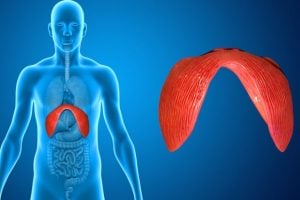 The diaphragm through its extensive insertions connects with many organs and structures, for example, the lumbar spine, and more specifically with the 1-3 lumbar vertebra, with the esophagus (which passes through the diaphragm), with the liver, stomach, spleen, colon, duodenum, heart using ligaments and lungs with pleural effusion. Respiratory movements of the diaphragm are strongly connected to the work of other organs through receptors. Thus, if the diaphragm’s work is disturbed, then the discomfort may even occur in distant organs. However, you can exercise the diaphragm yourself at home!
The diaphragm through its extensive insertions connects with many organs and structures, for example, the lumbar spine, and more specifically with the 1-3 lumbar vertebra, with the esophagus (which passes through the diaphragm), with the liver, stomach, spleen, colon, duodenum, heart using ligaments and lungs with pleural effusion. Respiratory movements of the diaphragm are strongly connected to the work of other organs through receptors. Thus, if the diaphragm’s work is disturbed, then the discomfort may even occur in distant organs. However, you can exercise the diaphragm yourself at home!
Continue reading “An organ underestimated by us, i.e. the diaphragm”
 Due to the fact that a large part of our society has a sedentary work style and often complains about back pain, we will present you the most optimal preparation of your workstation, so that your musculoskeletal system is in good shape.
Due to the fact that a large part of our society has a sedentary work style and often complains about back pain, we will present you the most optimal preparation of your workstation, so that your musculoskeletal system is in good shape.
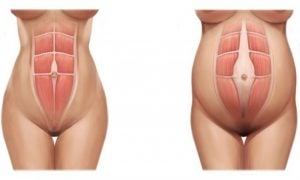 We take on a recently very popular subject, namely the abdominal muscle separation. Interestingly, this condition may affect both women after childbirth, people exercising abdominal muscles intensely, and people (more often men) with abdominal obesity, especially those who suffer from a smoker’s cough or having Chronic Obstructive Pulmonary Disease (COPD).
We take on a recently very popular subject, namely the abdominal muscle separation. Interestingly, this condition may affect both women after childbirth, people exercising abdominal muscles intensely, and people (more often men) with abdominal obesity, especially those who suffer from a smoker’s cough or having Chronic Obstructive Pulmonary Disease (COPD).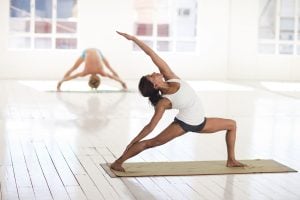 Time to take care of the joints we have forgotten, namely the hips. There is a lot of talk about the spine, shoulders, knees even more. What about the hips?
Time to take care of the joints we have forgotten, namely the hips. There is a lot of talk about the spine, shoulders, knees even more. What about the hips?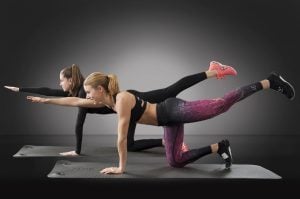 Time for another portion of the central stabilisation ‘core’ exercises. We hope that the previous ones, which we posted here some time ago, have already found their place in your routine and do not cause many difficulties. We remind you to perform each exercise in three series with a half a minute break between them.
Time for another portion of the central stabilisation ‘core’ exercises. We hope that the previous ones, which we posted here some time ago, have already found their place in your routine and do not cause many difficulties. We remind you to perform each exercise in three series with a half a minute break between them.  Unfortunately, because of our current lifestyle, where we stand or sit for most of the day, there is probably no person who hasn’t had a problem with aching spine at least once in his life. According to the principle that prevention is better than cure, there is a solution here. Maybe not everyone knows that deep muscles are responsible for our posture, creating so-called muscular corset. To strengthen it and thus protect against abnormal biomechanics of the spine and its pain, core stability should be exercised.
Unfortunately, because of our current lifestyle, where we stand or sit for most of the day, there is probably no person who hasn’t had a problem with aching spine at least once in his life. According to the principle that prevention is better than cure, there is a solution here. Maybe not everyone knows that deep muscles are responsible for our posture, creating so-called muscular corset. To strengthen it and thus protect against abnormal biomechanics of the spine and its pain, core stability should be exercised.  Do you feel numbness, weakness or pain in your hand? Do you notice that your hand turns chalky white or cyan blue? Is it getting cold or swollen?
Do you feel numbness, weakness or pain in your hand? Do you notice that your hand turns chalky white or cyan blue? Is it getting cold or swollen?  The diaphragm through its extensive insertions connects with many organs and structures, for example, the lumbar spine, and more specifically with the 1-3 lumbar vertebra, with the esophagus (which passes through the diaphragm), with the liver, stomach, spleen, colon, duodenum, heart using ligaments and lungs with pleural effusion. Respiratory movements of the diaphragm are strongly connected to the work of other organs through receptors. Thus, if the diaphragm’s work is disturbed, then the discomfort may even occur in distant organs. However, you can exercise the diaphragm yourself at home!
The diaphragm through its extensive insertions connects with many organs and structures, for example, the lumbar spine, and more specifically with the 1-3 lumbar vertebra, with the esophagus (which passes through the diaphragm), with the liver, stomach, spleen, colon, duodenum, heart using ligaments and lungs with pleural effusion. Respiratory movements of the diaphragm are strongly connected to the work of other organs through receptors. Thus, if the diaphragm’s work is disturbed, then the discomfort may even occur in distant organs. However, you can exercise the diaphragm yourself at home! Have you ever wondered what the effect of carrying a purse on your health is? The question may sound dangerous, but think about how much your bag weighs? Unfortunately, we walk with such a burden all day, for many, many years, because after all, handbags begin to be worn already in high school. Some people come up with the idea of putting books there and carrying them instead of a backpack. Now imagine what changes this leads to in your body: it starts to hurt your spine, and how! In addition, sometimes the shoulder ache, sometimes the head, and the neck also hurts …
Have you ever wondered what the effect of carrying a purse on your health is? The question may sound dangerous, but think about how much your bag weighs? Unfortunately, we walk with such a burden all day, for many, many years, because after all, handbags begin to be worn already in high school. Some people come up with the idea of putting books there and carrying them instead of a backpack. Now imagine what changes this leads to in your body: it starts to hurt your spine, and how! In addition, sometimes the shoulder ache, sometimes the head, and the neck also hurts …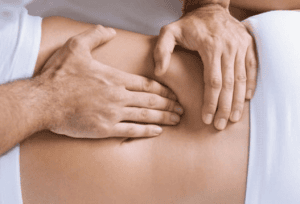 All organs in the human body are strongly connected with each other by means of ligament structures, the nervous system or fascia. If an organ undergoes dysfunction, it affects the work of other organs. For example, if the liver function is disturbed, then the diaphragm, right shoulder and even neck may deteriorate. In turn, excessive mesenteric pressure on the arteries, or impaired blood supply from the lower extremities to the liver can cause varicose veins.
All organs in the human body are strongly connected with each other by means of ligament structures, the nervous system or fascia. If an organ undergoes dysfunction, it affects the work of other organs. For example, if the liver function is disturbed, then the diaphragm, right shoulder and even neck may deteriorate. In turn, excessive mesenteric pressure on the arteries, or impaired blood supply from the lower extremities to the liver can cause varicose veins.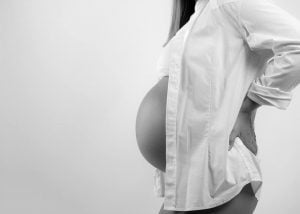 A lot of women coming to our practice with backaches or dizziness, tingling in their legs are surprised when I ask them if they had a Caesarean section. Where did you get that question from?
A lot of women coming to our practice with backaches or dizziness, tingling in their legs are surprised when I ask them if they had a Caesarean section. Where did you get that question from?